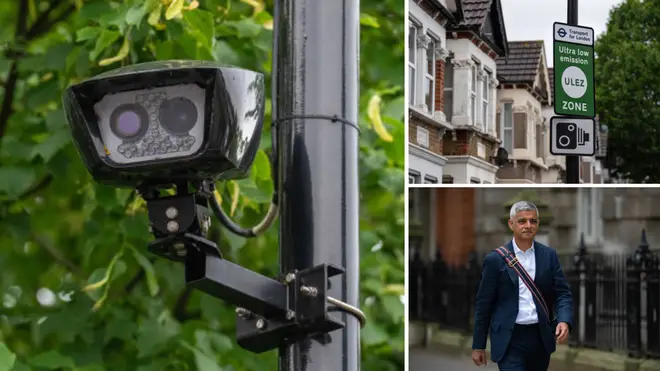
Daniel Barnett 9pm - 10pm
18 September 2023, 15:00 | Updated: 18 September 2023, 15:07

London's ultra-low emission zone (Ulez) was expanded in August to cover the whole of London, amid an outcry from aggrieved motorists.
The new rules mean that everyone who drives a more polluting car anywhere within the 32 London boroughs and the City of London has to pay a fee.
Sadiq Khan and Transport for London (TfL) enlarged the Ulez to cut air pollution, and improve Londoners' health and quality of life.
But anti-Ulez campaigners have said that the move is unfair on motorists who are already struggling with the cost of living. Some activists have even taken to defacing and vandalising cameras.

Cabinet Minister slams Sadiq Khan over Ulez
There are roughly 2,800 Ulez cameras dotted around London, although TfL has not released a definitive list.
Because the zone was originally in central London, many of the cameras are in the inner boroughs of the capital.
Since the expansion on August 29, TfL has installed more cameras in the outer boroughs.
Many of these are on the roads at the entrance to Ulez, to find drivers coming into the zone.
There are entrances to the Ulez that don't have cameras or where cameras are in place but have been disabled. But these places have not been made public.
This website has created a map of where the cameras are within London.
As well as static cameras, TfL is also thought to be using vans to enforce Ulez restrictions.
The vans do not directly say they are enforcing Ulez but have Transport for London markings and say they are carrying ANPR cameras.
Pictures have been posted on social media of camera vans having had their tyres slashed, windscreen smashed and graffiti daubed over it - one with the slogan "no Ulez". Anti-Ulez have also launched hundreds of attacks on the static cameras.

Khan defiant about Ulez expansion amid protests
Ulez cameras record a car's licence plate when it drives past. The number is then run through a database, which enables TfL to check what kind of car it belongs to.
This lets TfL know if the person driving the car needs to be charged for entering a low-emission zone.
Ulez works 24 hours a day, seven days a week, 364 days a year.
The one exception is Christmas day.

The Ulez charge applies to all vehicles that have emissions standards older than Euro 4 for petrol engines, or Euro 6 for diesel engines.
That means that petrol vehicles registered before 2005 and diesel vehicles registered before 2015 are likely to have pay the charge.
Taxis, historic vehicles older than 40 years old, and vehicles with a 'disabled' or 'disabled passenger vehicles' tax class are exempt.

Drivers of cars, smaller vans and motorbikes that don't meet Ulez standards have to pay £12.50 a day to drive within the zone.
Lorries, buses, coaches and heavy vans that are non-compliant are charged £100 under the separate low emission zone scheme, which already covers most of London.

London is plagued by bad air pollution, which seriously affects the health of many people who live in the capital.Research by Imperial College London, cited by Mr Khan, found that in 2019, 4,000 Londoners died prematurely from conditions related to air pollution.
The British Heart Foundation also found that living in some especially-polluted areas of London is as bad for you as smoking 150 cigarettes a year.
Air pollution is seen as a contributory factor to deaths, like smoking, so is not normally listed on death certificates.
But in 2020, a coroner listed air pollution as a cause of death of Ella Kissi-Debrah, a nine-year-old girl who lived in Lewisham, south London, close to the busy South Circular. This was a global first.

Ulez has proved an extremely controversial issue. Many people support the scheme to improve London's air quality. But many others argue that it targets working people who need a vehicle to get around, making their lives harder and more expensive at a time when other costs are also going up.
Some have also disputed the environmental science behind the policy. Anti-Ulez activists have demonstrated throughout the capital, demanding that Mr Khan halt the expansion.
Susan Hall, Mr Khan's Conservative opponent in next year's mayoral election, has said she will scrap the expansion if she is elected.
Instead she will "set up a £50m pollution hotspots fund to tackle the issue where it is, instead of taxing people where it isn't," Ms Hall said.
Ulez is even thought to have been a factor in Labour not winning Uxbridge and South Ruislip from the Conservatives in a by-election over the summer.